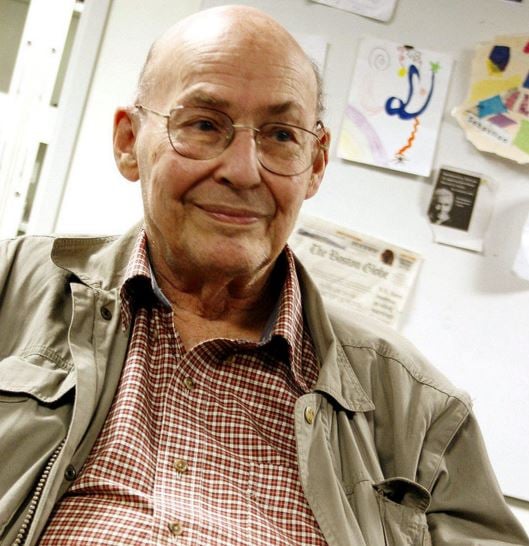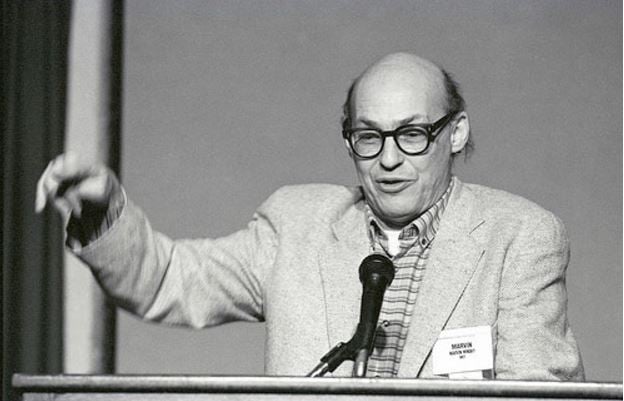Known as the father of artificial intelligence, Marvin Minsky died on Sunday, January 24, aged 88, at Boston’s Brigham and Women’s Hospital of a cerebral hemorrhage, MIT’s Media Lab reported.
Marvin Lee Minsky (1927 – 24 Jan 2016), born in New York City, was a cognitive scientist in the field of AI (artificial intelligence). He was co-founder of CSAIL (MIT: Computer Science and Artificial Intelligence Laboratory) and wrote several texts on philosophy and AI. He was also a mathematician and computer scientist.
Cognitive science is the study of thought, learning and mental organization – it draws on aspects of psychology, philosophy, linguistics, and computer modelling.
 Marvin Lee Minsky (Aug 9, 1927 – Janu 24, 2016), the ‘Father of Artificial Intelligence’. RIP. (Image: Wikipedia)
Marvin Lee Minsky (Aug 9, 1927 – Janu 24, 2016), the ‘Father of Artificial Intelligence’. RIP. (Image: Wikipedia)
The leading expert on AI
According to MIT, where he was a professor emeritus at the Media Lab, he was a pioneering thinker and the leading expert on the theory of artificial intelligence.
In his book – The Society of Mind – published in 1985, Prof. Minsky constructed a model of human intelligence step by step, built up from interactions of simple parts (agents), which are themselves mindless. He described the postulated interactions as constituting the ‘society of mind’, hence the title.
The Society of Mind is today considered a seminal exploration of intellectual structure and function, which enhanced our understanding of the diversity of mechanisms interacting thought and intelligence.
His last book – The Emotion Machine: Commonsense Thinking, Artificial Intelligence, and the Future of the Human Mind – was published in 2006. In the book he argued that emotions, intuitions, and feelings are not distinct things, but different ways of thinking. If we examine these different forms of mind activity, we can explain why our thought sometimes takes the form of carefully reasoned analysis, while at other times turns to emotion, he wrote.
Replicating human brain function in a computer
According to Prof. Minsky, the brain is a machine whose functioning can be studied and replicated within a computer. This would, in turn, give us a better understanding of the human brain and higher-level mental functions.
We need to provide machines with common sense, he said. The knowledge we acquire on a daily basis through experience, such as, dragging an object – one needs to pull not push – needs to be taught to a sophisticated computer. Most of these concepts are second-nature to a two-year old human child.
 Prof. Minsky with his ‘tentacle arm’ in 1980. It was a 12-jointed arm moved like an octopus and could reach around obstacles. (Image: cyberneticzoo.com)
Prof. Minsky with his ‘tentacle arm’ in 1980. It was a 12-jointed arm moved like an octopus and could reach around obstacles. (Image: cyberneticzoo.com)
Prof. Minsky entered Harvard University after completing his military service in the US Navy during the Second World War.
He graduated from Harvard with honours in 1950, and then went on to Princeton University where he received his PhD in mathematics in 1954. In Princeton, during his first year, he built his first neural network simulator.
Co-founded CSAIL
In 1958, he joined the Department of Electrical Engineering and Computer Science at MIT, and in the following year co-founded the Artificial Intelligence Laboratory (AI Lab), which today is called the Computer Science and Artificial Intelligence Laboratory (CSAIL). The co-founder, colleague John McCarthy, is credited with coining the term ‘artificial intelligence.’
At the AI Lab, his aim was to explore how we could endow machines with human-like intelligence and perception. He designed and created robotic hands that could manipulate objects, developed a number of new programming frameworks, and wrote several texts on the philosophical issues in AI.
 “No computer has ever been designed that is ever aware of what it’s doing; but most of the time, we aren’t either.” (Marvin Minsky)
“No computer has ever been designed that is ever aware of what it’s doing; but most of the time, we aren’t either.” (Marvin Minsky)
CSAIL Director Daniela Rus, the Andrew and Erna Viterbi Professor in MIT’s Department of Electrical Engineering and Computer Science, said:
“Marvin Minsky helped create the vision of artificial intelligence as we know it today. The challenges he defined are still driving our quest for intelligent machines and inspiring researchers to push the boundaries in computer science.”
Machines as intelligent as humans
Prof. Minsky believed that one day we would develop machines as smart as humans. In recent years, he was frustrated by a shortage of both funding and researchers.
Regarding making machines as intelligent as humans, Prof. Minsky said:
“How long this takes will depend on how many people we have working on the right problems.”
 According to Wikipedia, Prof. Minsky was an atheist and a signatory to the Scientists’ Open Letter on Cryonics.
According to Wikipedia, Prof. Minsky was an atheist and a signatory to the Scientists’ Open Letter on Cryonics.
Prof. Minsky became a founding member of the MIT Media Lab, where he was named the Toshiba Professor of Media Arts and Sciences. He had continued teaching and mentoring there until recently.
The MIT Media Lab is an interdisciplinary research laboratory that focusses on the convergence of technology, sciences, multimedia, art and design. Staff and students come from a wide range of backgrounds including computer science, electrical engineering, music, sociology, etc.
Professor Nicholas Negroponte, co-founder and chairman emeritus of the Media Lab, said:
“Marvin talked in riddles that made perfect sense, were always profound and often so funny that you would find yourself laughing days later. His genius was so self-evident that it defined ‘awesome.’ The Lab bathed in his reflected light.”
A gifted pianist
Prof. Minsky was a talented pianist. He was one of the few pianists globally who could improvise fugues, the polyphonic counterpoint that distinguish Western classical music.
He invented the earliest confocal scanning microscope. Confocal microscopy is an optical imaging technique for improving the optical resolution and contrast of a micrograph by adding a spatial pinhole placed at the confocal plane of the lens to eliminate out-of-focus light.
Prof. Minsky was also involved in the inventions of the first cursor (turtle) for the LOGO programming language, with Seymour Papert and the Triadex Muse synthesizer for musical variations with Ed Fredkin.
Awards and affiliations
1969: he received the A.M. Turing Award – recognized as the highest distinction in computer science; the ‘Nobel Prize of computing’.
1990: the Japan Prize – awarded by the Japan Prize Foundation to people from all parts of the world whose “original and outstanding achievements in science and technology are recognized as having advanced the frontiers of knowledge and served the cause of peace and prosperity for mankind.”
1991: the IJCAI Award for Research Excellence.
2001: the Benjamin Franklin Medal from the Franklin Institute.
2006: he was inducted as a Fellow of the Computer History Museum for “co-founding the field of artificial intelligence, creating early neural networks and robots, and developing theories of human and machine cognition.”
2011: he was inducted into the IEEE (Institute of Electrical and Electronics Engineers) Intelligent Systems’ AI’s Hall of Fame.
2013: he received the BBVA Foundation Frontiers of Knowledge Award in Information and Communication Technologies category.
2014: he was awarded the Dan David Prize in the field of ‘Artificial Intelligence, the Digital Mind’. The Dan David Prize is awarded for innovative and interdisciplinary research. Prize winners donate 10% of their $1 million prize money to doctoral scholarships for outstanding Ph.D. students and postdoctoral scholarships for outstanding researchers in their own field from across the world. A scholarship is a form of financial help for students who reach a certain academic level and (usually) have a financial need.
People sought Prof. Minsky’s advice from a wide range of fields. While preparing to make the movie 2001: A Space Odyssey in the 1960s, film director Stanley Kubrick visited him, seeking to learn more about the state of computer graphics. Kubrick asked Prof. Minsky whether he thought that computers might be speaking articulately by 2001.
Prof. Minsky is survived by Gloria Rudisch Minsky, MD, his wife, and three children: Margaret, Juliana and Henry Minsky.
His family requests that memorial contributions be directed to the Marvin Minsky Foundation, which supports research in AI, including support for graduate students.
Later this year, the MIT Media Lab says it plans to hold a celebration of Prof. Minsky’s life.
Marvin Minsky quotes
Below are some phrases he said that stand out..
– “You don’t understand anything until you learn it more than one way.”
– “Societies need rules that make no sense for individuals. For example, it makes no difference whether a single car drives on the left or on the right. But it makes all the difference when there are many cars!”
– “In general we are least aware of what our minds do best.”
– “There are three basic approaches to AI: Case-based, rule-based, and connectionist reasoning.”
Video – Marvin Minsky and Danny Hillis
Alum Danny Hillis talks to Marvin Minsky, his mentor, about fostering curiosity and creativity in students, his frustration with the progress of artificial intelligence, and his hope that the work was picking up again.
